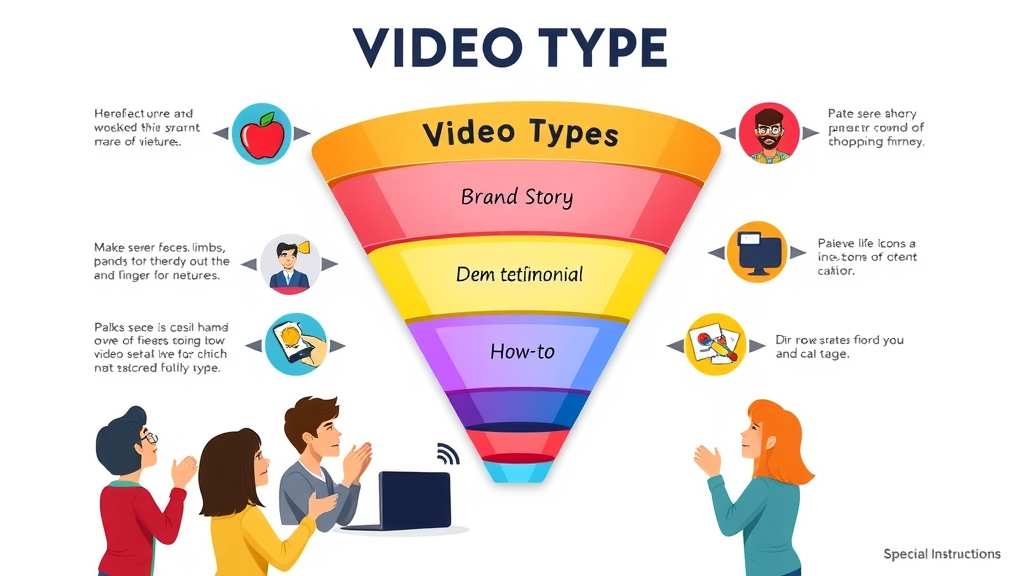Are you ready to unlock the sales-boosting power of video marketing strategies ? With attention spans shrinking and competition intensifying, today’s brands must harness the full potential of video to break through the noise, connect emotionally, and convert viewers into loyal customers. This comprehensive guide reveals how you can use video content to increase engagement, build trust, and—most importantly—supercharge your sales.
Unlock the Power of Video Marketing Strategies
In today’s landscape, video marketing strategies offer businesses a significant advantage in both reach and results. With more people streaming and sharing video content than ever before, marketing professionals are capitalizing on the unique ability of videos to quickly grab interest and convey complex ideas simply. A well-crafted video not only captures the attention of potential customers but also resonates on an emotional level, leaving a lasting impression that static ads or plain text can seldom achieve.
By weaving video into your marketing plan, you're setting up opportunities to drive engagement at every sales funnel stage. Strategic videos can introduce your brand, demonstrate products, showcase satisfied customers, and keep your brand top-of-mind post-purchase. The result? Higher conversions, improved recall, and real bottom-line growth for forward-thinking organizations.
Why Effective Video Marketing Strategies Matter in Today’s Digital Landscape
In a crowded digital marketplace, grabbing and holding your audience’s attention is harder than ever. Effective video marketing strategies offer a powerful way to cut through the noise and connect with viewers in meaningful ways. Studies show that video content is not only more engaging but also more memorable, making it easier for brands to communicate value and stand out. Videos can make otherwise complex products understandable, demonstrate real-world benefits, and show off social proof through testimonials—all in a matter of seconds.
Beyond information, videos evoke feelings and build authenticity. When viewers see your team, hear satisfied clients, or experience your product in action, trust increases—and so does the likelihood of purchase. As algorithms continue to prioritize video content on social platforms and search engines, brands that fully embrace video marketing outperform those that don’t. Investing in proven video marketing strategies isn't just a trend—it's a necessity for staying competitive and relevant in the digital age.

- Capture attention in a saturated market
- Build stronger emotional connections with audiences
- Drive conversions and boost sales with compelling visuals
Case Study: Brands That Increased Sales Through Video Marketing Strategies
Take, for example, brands like Dollar Shave Club and Blendtec , both of which used quirky, informative videos that went viral—and directly translated to sales spikes. Dollar Shave Club’s launch video was relatable, memorable, and packed with personality, resulting in over 12,000 orders in the first two days. Similarly, Blendtec’s “Will It Blend?” series showcased the product’s power in fun, unexpected ways, leading to massive engagement and a surge in sales.
Even beyond direct-to-consumer brands, B2B companies are leveraging case study videos, product demos, and webinars to connect with prospects and clinch deals faster. By mixing creativity and strategic distribution, brands in every industry have demonstrated that video isn’t just about views—it’s about measurable results and revenue growth.
"84% of people say that they’ve been convinced to buy a product or service by watching a brand’s video." – Wyzowl, Video Marketing Statistics 2024
Key Elements of Successful Video Marketing Strategies
Crafting successful video marketing strategies involves more than hitting record. It’s about pinpointing your audience, matching the right video style to your goals, and ensuring every element—message, SEO, promotion—works together seamlessly. Smart marketers start by understanding who they want to reach and why, crafting content that is both relevant and irresistible.
From explainer videos and testimonials to engaging social clips and detailed product demos, every video should align with your sales funnel stage and brand personality. High-quality storytelling and clear calls-to-action are musts, but optimizing for discoverability is just as crucial. No matter how creative, your video needs to be found by the right eyes, which means strategically embedding keywords, tags, and SEO best practices. Finally, go beyond organic reach by amplifying your videos with social media ads, partnerships, or influencer sharing—all while keeping your brand’s voice clear and consistent.
- Identifying your target audience
- Choosing the right video type (explainer, testimonial, demo, etc.)
- Crafting a resonant brand message
- Optimizing video SEO for maximum reach
- Leveraging social media and paid promotion tactics
Table: Video Types for Each Sales Funnel Stage
Understanding which video format aligns best with your customer’s stage in the buying journey is vital. The right type of video, deployed at the right time, can mean the difference between a passive viewer and a loyal customer.
| Funnel Stage | Video Type | Purpose |
|---|---|---|
| Awareness | Brand Story, Teaser | Capture attention, build interest |
| Consideration | Product Demo, FAQ | Educate, anticipate objections |
| Conversion | Testimonial, Offer | Drive action, foster trust |
| Loyalty | How-to, Behind Scenes | Engage post-purchase, upsell |

How to Create a Winning Video Marketing Strategy
Building a winning video marketing strategy isn’t about following trends—it’s about fixing your sights on your goals, mapping content to audience needs, and optimizing every touchpoint. Start with clear objectives, then tailor your video content to speak to viewers where they are in their journey, refining every detail for maximum impact and shareability.
Whether you’re launching your first campaign or leveling up an existing one, a structured approach ensures results. Setting goals will guide your creative process, while a content map will help personalize messaging, measure effectiveness, and drive viewers to take action at every step.
Set Clear Objectives for Your Video Marketing Strategies
Before hitting “record,” identify the purpose for each video. Do you want to generate leads, drive sales, or build brand awareness? Define Key Performance Indicators (KPIs) such as views, engagement rates, or conversion rates to evaluate progress. By aligning your goals with the overarching marketing strategy, you avoid wasted resources and ensure each video delivers measurable value.
For example, if growing email signups is a goal, your KPI could be sign-up conversions after watching a demo video. Or, if boosting loyalty, track repeat purchase rates among those who viewed post-purchase how-to videos. Clearly stated objectives keep your team focused and align video themes with business targets.
- Define relevant KPIs for tracking success
- Align video goals with overall marketing objectives
Plan Content According to the Customer Journey
Effective video marketing strategies are mapped to your customer’s journey—from the first touchpoint to ongoing loyalty. Start by brainstorming video topics that address awareness (introducing your brand), consideration (product demos, explainer videos), conversion (testimonials), and loyalty (how-tos, unboxing, or behind-the-scenes content). This alignment fosters a seamless transition down the sales funnel and eliminates content gaps that could leave viewers disengaged.
Go further by personalizing video content using data from past interactions. If your analytics show prospects are most likely to convert after a demo, prioritize these videos for remarketing efforts. Similarly, segment emails by buyer stage and embed tailored videos that address specific pain points. Brands that use personalization and journey mapping see higher video retention, more shares, and better sales outcomes.
- Map video topics to each stage of the buyer’s journey
- Personalize video experiences for better engagement

Optimize Video for Search Engines and Social Sharing
Creating an amazing video is only half the battle; ensuring it’s discoverable is just as critical. Use keyword-rich titles and detailed descriptions to help your videos rank in YouTube, Google, and other search platforms. Include transcripts to boost accessibility and contribute valuable, crawlable content for SEO. Platforms like YouTube also let you add tags—use them wisely to appear in relevant suggestions and searches.
Don’t forget to encourage engagement. Invite viewers to like, share, and comment, which strengthens video reach in social algorithms. Experiment with different thumbnails and video start points to see what sparks interaction. The more people engage, the greater your video’s visibility, helping you extend your brand’s impact organically and through sharing.
- Use keyword-rich video titles and descriptions
- Implement transcripts for accessibility and SEO
- Encourage audience interaction (likes, shares, comments)

Leveraging Video Marketing Strategies for Sales Growth
Now that you understand the basics of creating and distributing optimized video content , it’s time to link your videos directly to sales growth. Video marketing isn’t just about generating awareness—when strategically deployed, it becomes a core part of lead nurturing, conversion, and even customer upsell.
Effective marketers tie videos into every part of the customer’s experience—whether it’s through personalized emails, engaging retargeting ads, or user-specific video recommendations on-site. The data is clear: videos that meet viewers at key points in the buying journey outperform static content, driving higher conversion rates and a stronger return on investment (ROI).
Integrating Video Into Email Marketing Campaigns
Trigger higher open rates, increased click-throughs, and better overall engagement by embedding videos directly into your email marketing campaigns. Videos in emails grab attention quickly, summarize value propositions more efficiently than text, and often lead to a measurable boost in conversions. For example, product demo videos can entice prospects to move down the sales funnel, while personalized thank-you or onboarding videos foster customer loyalty after purchase.
When using video in email, use compelling subject lines (“Watch This Now”) and tease video content with GIFs or enticing thumbnails. Many leading email platforms now support seamless embedding or provide auto-play previews, making it easier than ever to deliver dynamic content straight to someone’s inbox.
Retargeting Audiences With Tailored Video Content
Retargeting allows you to show specific video ads to users who have previously interacted with your brand. For example, if someone visited your product page but didn’t buy, follow up with a video that addresses common objections or highlights customer success stories. This personalized approach maintains your brand’s relevance and nudges prospects back toward conversion.
Tailored retargeting also works well for cross-sell and upsell opportunities. Segment your audience so previous buyers receive videos about complementary products or advanced features, keeping them engaged and moving through your sales cycle. This targeted, video-driven approach is proven to increase engagement and revenue in both B2C and B2B spaces.

Maximizing Results With Data-Driven Video Marketing Strategies
Maximizing the ROI of your video marketing strategies hinges on using data intelligently. By tracking key performance metrics, experimenting with content variables, and leveraging analytics to guide decision-making, you transform guesswork into systematic growth.
Today’s advanced analytics platforms empower marketers to see exactly which videos are driving views, engagements, and sales. Make sure every campaign is tied to clear KPIs, and use A/B testing on thumbnails, ad copy, or calls-to-action to continuously upgrade your content’s effectiveness.
Analyzing Video Performance and Refining Your Approach
Regular analysis keeps your strategy sharp. Focus on metrics like total views, average watch time, audience retention, and—most important—conversion rates tied to video interactions. If a particular type of video or distribution platform consistently outperforms, allocate more resources there. If not, adjust your approach: change the video format, messaging, or even your publishing schedule.
Don’t be afraid to experiment. A/B test different thumbnails, headlines, or calls to action and measure results meticulously. Over time, this kind of data-driven refinement leads to more engaging videos and, most importantly, stronger sales outcomes that can be scaled up as you grow.
- Track metrics: views, watch time, conversion rates
- Use A/B testing to optimize thumbnail and CTA
Tools to Supercharge Your Video Marketing Strategies
To execute on your goals efficiently, leverage the best tools for creation, management, and analytics. Popular platforms like Canva, Wistia, and Vimeo offer intuitive interfaces for editing and publishing, while YouTube Studio and dedicated analytics dashboards make tracking your video’s performance straightforward. Look for platforms that provide insights into audience demographics, traffic sources, engagement flows, and drop-off points.
Over time, these tools help refine your content distribution strategy, schedule posts for maximum reach, and discover what types of videos convert best for your audience. Invest in tools that integrate with your existing marketing tech stack, ensuring that video metrics are easily incorporated into campaign reporting and overall ROI assessments.
- Video creation platforms (Canva, Wistia, Vimeo)
- Analytics dashboards for tracking campaigns

People Also Ask: Can Video Marketing Strategies Work for Small Businesses?
Answer: Absolutely! Video marketing strategies are scalable and flexible, making them accessible to businesses of any size. Small businesses can use affordable video tools and platforms to create impactful content tailored to their audiences, resulting in strong engagement and sales growth.
People Also Ask: How Do I Measure the ROI of My Video Marketing Strategies?
Answer: Track specific KPIs such as video views, average watch duration, click-through rates, and most importantly, conversion rates tied to video campaigns. Use analytics tools from YouTube, Vimeo, and your website to connect your videos directly to sales outcomes.
FAQs About Video Marketing Strategies
- What platforms are best for video marketing strategies? The best platforms depend on your target audience, but YouTube, Facebook, Instagram, TikTok, and LinkedIn are popular for their broad reach and robust analytics. Consider where your customers spend time and start there.
- How often should I publish new videos? Consistency matters more than frequency. Start with a manageable schedule—such as biweekly or monthly—and prioritize quality over quantity. Track audience engagement to refine your posting cadence.
- How do I create video content on a budget? Use affordable tools like smartphones, free editing apps, and DIY studio setups. Focus on clear audio, natural lighting, and concise messaging. Many successful brands started with minimal production budgets and scaled as results improved.
- What are the latest trends in video marketing strategies? Trends include short-form vertical videos, livestreams, personalized video messages, shoppable videos, and using AI to optimize content delivery times. Staying updated on new formats helps keep your strategy ahead of the curve.
Take the Next Step with Video Marketing Strategies
Put these actionable video marketing strategies to work. Start mapping your funnel, testing new video types, and tracking results. Every step takes your brand closer to loyal fans—and bigger sales.
To deepen your understanding of effective video marketing strategies, consider exploring the following resources:
- “16 Video Marketing Strategies for 2025” ( designrush.com )
This article outlines key strategies such as authentic storytelling, enhancing video SEO, and utilizing user-generated content to boost engagement and sales.
- “8 Tips for an Effective Video Marketing Strategy” ( webfx.com )
This guide provides practical advice on creating a posting schedule, incorporating tutorials and demos, and telling compelling stories to connect with your audience.
If you’re serious about leveraging video marketing to boost your sales, these resources will provide you with actionable strategies and insights to enhance your campaigns.
 Add Row
Add Row  Add
Add 




Write A Comment